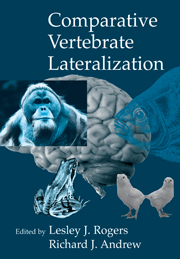Book contents
- Frontmatter
- Contents
- List of Contributors
- Preface
- Introduction
- Part one Evolution of lateralization
- Part two Development of lateralization
- Part three Cognition and lateralization
- 10 Evidence for cerebral lateralization from senses other than vision
- 11 Facing an obstacle: Lateralization of object and spatial cognition
- 12 Laterality of communicative behaviours in non-human primates: A critical analysis
- 13 Specialized processing of primate facial and vocal expressions: Evidence for cerebral asymmetries
- Part four Lateralization and memory
- Epilogue
- Author Index
- Subject Index
- Richard Andrew
11 - Facing an obstacle: Lateralization of object and spatial cognition
Published online by Cambridge University Press: 10 December 2009
- Frontmatter
- Contents
- List of Contributors
- Preface
- Introduction
- Part one Evolution of lateralization
- Part two Development of lateralization
- Part three Cognition and lateralization
- 10 Evidence for cerebral lateralization from senses other than vision
- 11 Facing an obstacle: Lateralization of object and spatial cognition
- 12 Laterality of communicative behaviours in non-human primates: A critical analysis
- 13 Specialized processing of primate facial and vocal expressions: Evidence for cerebral asymmetries
- Part four Lateralization and memory
- Epilogue
- Author Index
- Subject Index
- Richard Andrew
Summary
Introduction
We might not be surprised by the fact that a predator may wait for the reappearance of a prey that has, momentarily, disappeared from view, or by the fact that the predator's prey remains motionless even when the predator has vanished temporarily from view or is only partly visible because it partly occluded by some obstacles. There could be (in some species, at least) several different abilities operating in these situations and, although such sorts of behaviours can be observed rather commonly in a natural environment, a scientific investigation on these aspects of higher cognition has begun only recently.
As human adults, we perceive our surroundings as a layout of continuous surfaces furnished with physical objects. According to the traditional Piagetian perspective, the ability to do this is actually the final outcome of a progression of stages. For instance, at a certain age, an infant will be able to grasp a partly hidden object, whereas a fully hidden one will not be retrieved. This sort of ‘object permanence’ for stimuli that are completely (not just partially) out of sight is, according to Piaget (1953), not developed in humans before the age of 7–8 months.
- Type
- Chapter
- Information
- Comparative Vertebrate Lateralization , pp. 383 - 444Publisher: Cambridge University PressPrint publication year: 2002
- 17
- Cited by



